
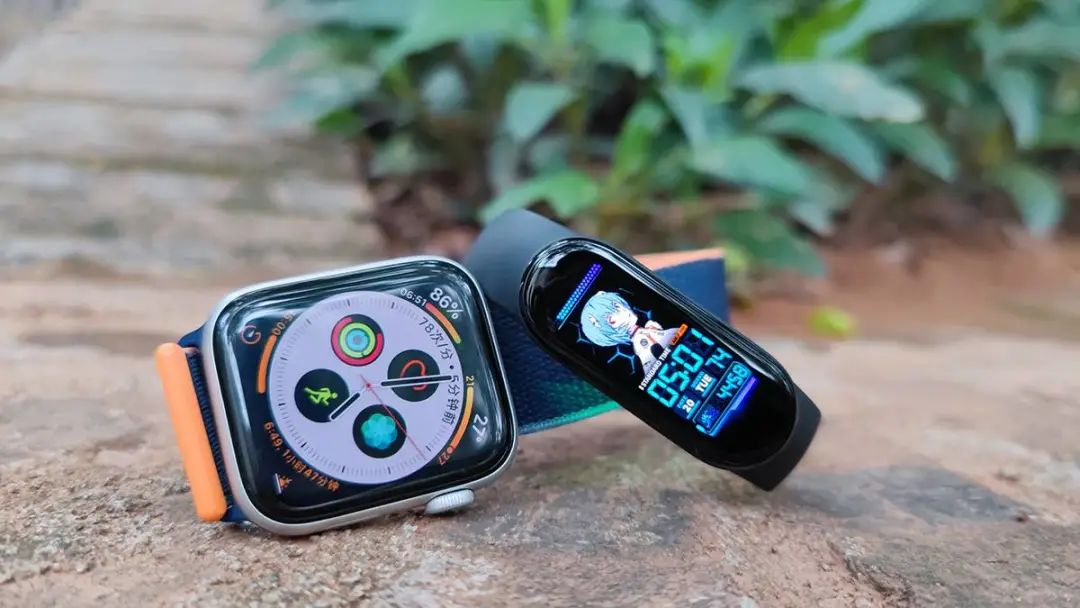 When the Apple Watch SE was released, many praised Apple’s conscience. This is because, apart from lacking blood oxygen monitoring and an always-on display, its features and design are almost identical to the flagship Apple Watch S6, yet it is priced 1000 Yuan lower. In fact, the well-reviewed and reasonably priced Apple Watch SE starts at 2199 Yuan, which is enough to buy a decent smartphone.
When the Apple Watch SE was released, many praised Apple’s conscience. This is because, apart from lacking blood oxygen monitoring and an always-on display, its features and design are almost identical to the flagship Apple Watch S6, yet it is priced 1000 Yuan lower. In fact, the well-reviewed and reasonably priced Apple Watch SE starts at 2199 Yuan, which is enough to buy a decent smartphone.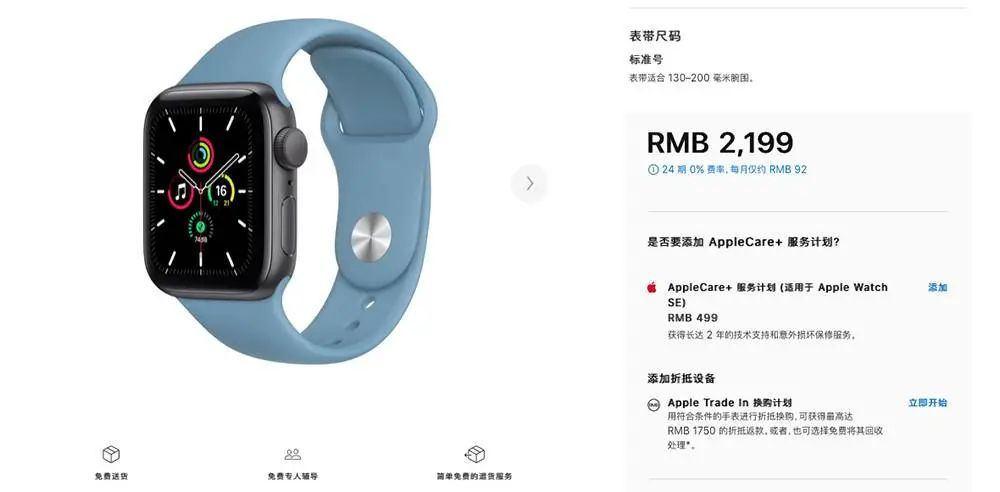 If your budget is not that high and you want to experience wearable devices, you can purchase a fully functional fitness band for around 200 Yuan. At this point, some may ask: with seemingly similar functionalities, what accounts for the nearly tenfold price difference? Should one choose a smartwatch or a fitness band to experience wearable technology? However, with the development of wearable devices over the years, the line between smartwatches and fitness bands has become increasingly blurred, with many smartwatches being jokingly referred to as “large fitness bands.” Therefore, we should first define the two.
If your budget is not that high and you want to experience wearable devices, you can purchase a fully functional fitness band for around 200 Yuan. At this point, some may ask: with seemingly similar functionalities, what accounts for the nearly tenfold price difference? Should one choose a smartwatch or a fitness band to experience wearable technology? However, with the development of wearable devices over the years, the line between smartwatches and fitness bands has become increasingly blurred, with many smartwatches being jokingly referred to as “large fitness bands.” Therefore, we should first define the two. Xiaomi Mi Band 6. Image from: mi.comSmartwatch: A wearable device that can download apps and operate independently, such as the Apple Watch S6, Xiaomi Watch, OPPO Watch, etc.; Fitness Band: A wearable device that cannot download apps and can only use built-in features, such as the Huawei Band 6, Xiaomi Watch Color, etc. Now, let’s compare the user experience of the Apple Watch SE (starting at 2199 Yuan) and the Xiaomi Mi Band 6 (starting at 229 Yuan) to see how much difference the tenfold price brings us.
Xiaomi Mi Band 6. Image from: mi.comSmartwatch: A wearable device that can download apps and operate independently, such as the Apple Watch S6, Xiaomi Watch, OPPO Watch, etc.; Fitness Band: A wearable device that cannot download apps and can only use built-in features, such as the Huawei Band 6, Xiaomi Watch Color, etc. Now, let’s compare the user experience of the Apple Watch SE (starting at 2199 Yuan) and the Xiaomi Mi Band 6 (starting at 229 Yuan) to see how much difference the tenfold price brings us. A healthy life on your wristFrom recording body data to supporting various fitness activities, whether it’s Apple, Huawei, or Xiaomi, the health-related features occupy a significant portion of their wearable device sales interfaces. Using wearable devices to make life healthier has almost become a consensus between manufacturers and users.
A healthy life on your wristFrom recording body data to supporting various fitness activities, whether it’s Apple, Huawei, or Xiaomi, the health-related features occupy a significant portion of their wearable device sales interfaces. Using wearable devices to make life healthier has almost become a consensus between manufacturers and users.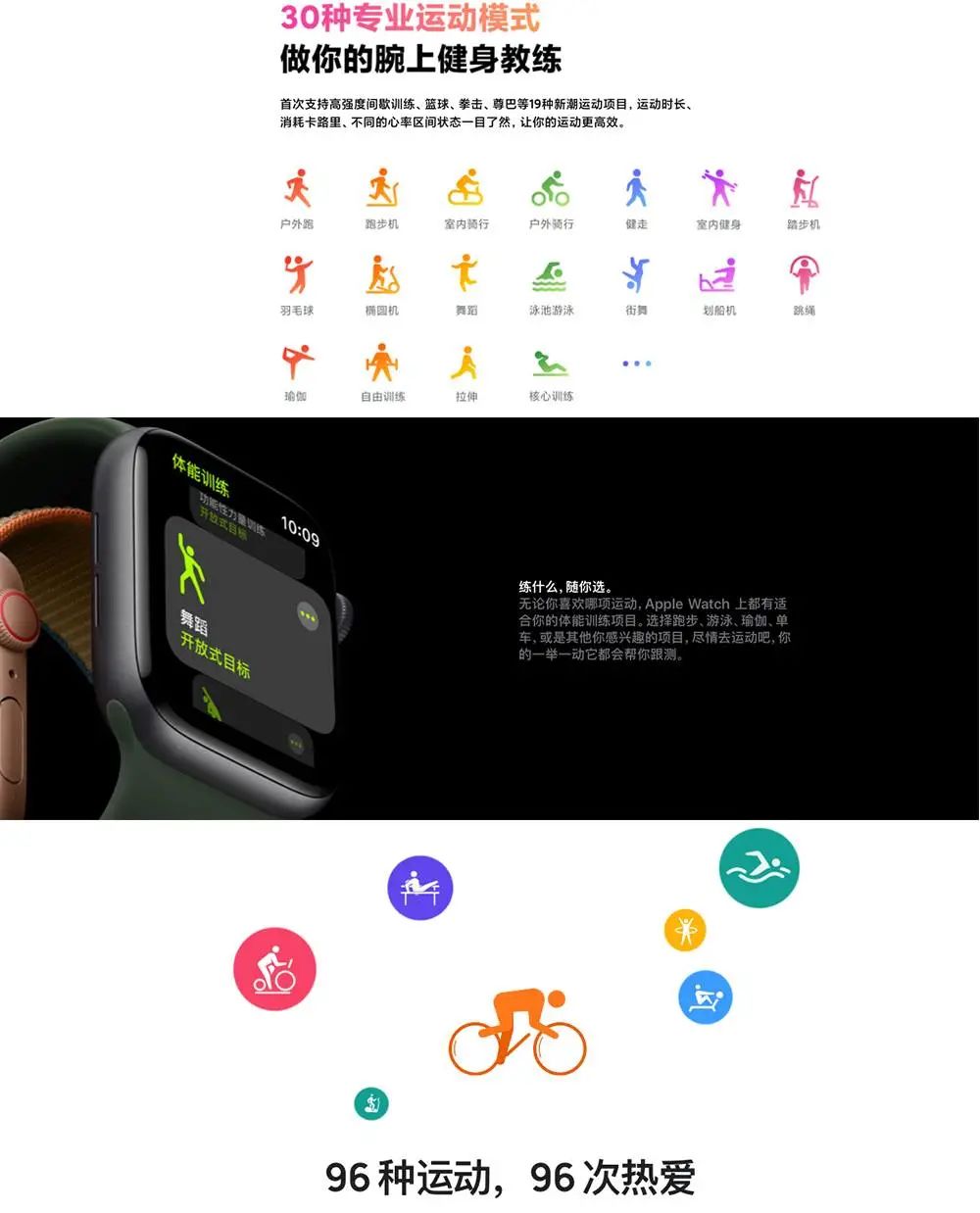 Screenshots from the official websites of Xiaomi, Apple, and Huawei (in no particular order)Now, let’s take a look at the strengths of fitness bands and smartwatches in terms of body data detection and fitness tracking!Daily tracking, effortlessFrom step counting and heart rate monitoring to sleep tracking, from sedentary reminders to fitness prompts, both smartwatches and fitness bands provide a wealth of tracking options. Taking the Xiaomi Mi Band 6 as an example, it can record data such as steps, heart rate, sleep, blood oxygen, and menstrual cycle, and it also has reminders for sedentary behavior, breathing exercises, personal vitality index, and stress detection. This wealth of data basically meets our daily tracking needs.
Screenshots from the official websites of Xiaomi, Apple, and Huawei (in no particular order)Now, let’s take a look at the strengths of fitness bands and smartwatches in terms of body data detection and fitness tracking!Daily tracking, effortlessFrom step counting and heart rate monitoring to sleep tracking, from sedentary reminders to fitness prompts, both smartwatches and fitness bands provide a wealth of tracking options. Taking the Xiaomi Mi Band 6 as an example, it can record data such as steps, heart rate, sleep, blood oxygen, and menstrual cycle, and it also has reminders for sedentary behavior, breathing exercises, personal vitality index, and stress detection. This wealth of data basically meets our daily tracking needs.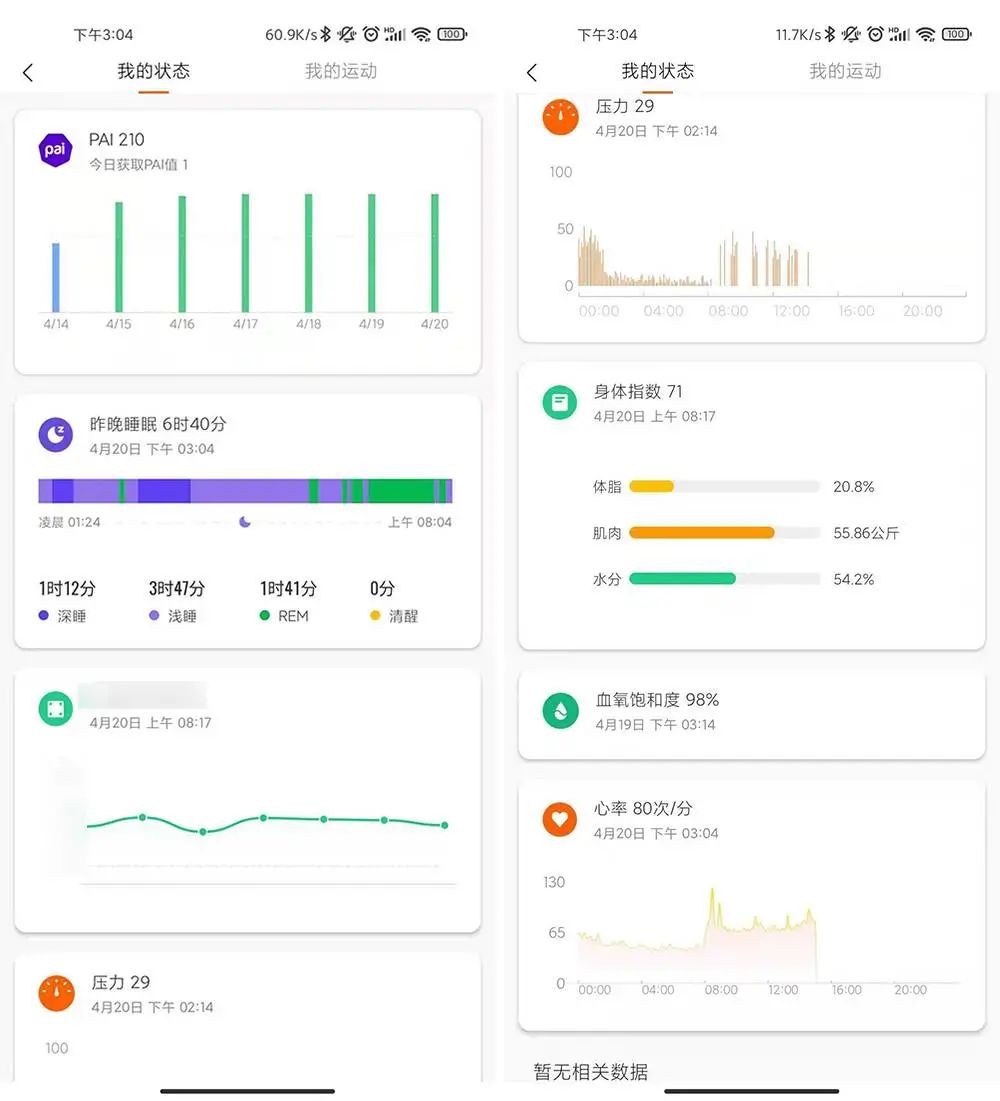 Data will be clearly recorded in the appThe Apple Watch is similar; it can do everything that a fitness band can do in terms of body data detection (blood oxygen detection requires purchasing the Apple Watch S6). It can also monitor stair climbing speed, stride length, gait asymmetry, and double support time, allowing you to better understand your physical condition.
Data will be clearly recorded in the appThe Apple Watch is similar; it can do everything that a fitness band can do in terms of body data detection (blood oxygen detection requires purchasing the Apple Watch S6). It can also monitor stair climbing speed, stride length, gait asymmetry, and double support time, allowing you to better understand your physical condition.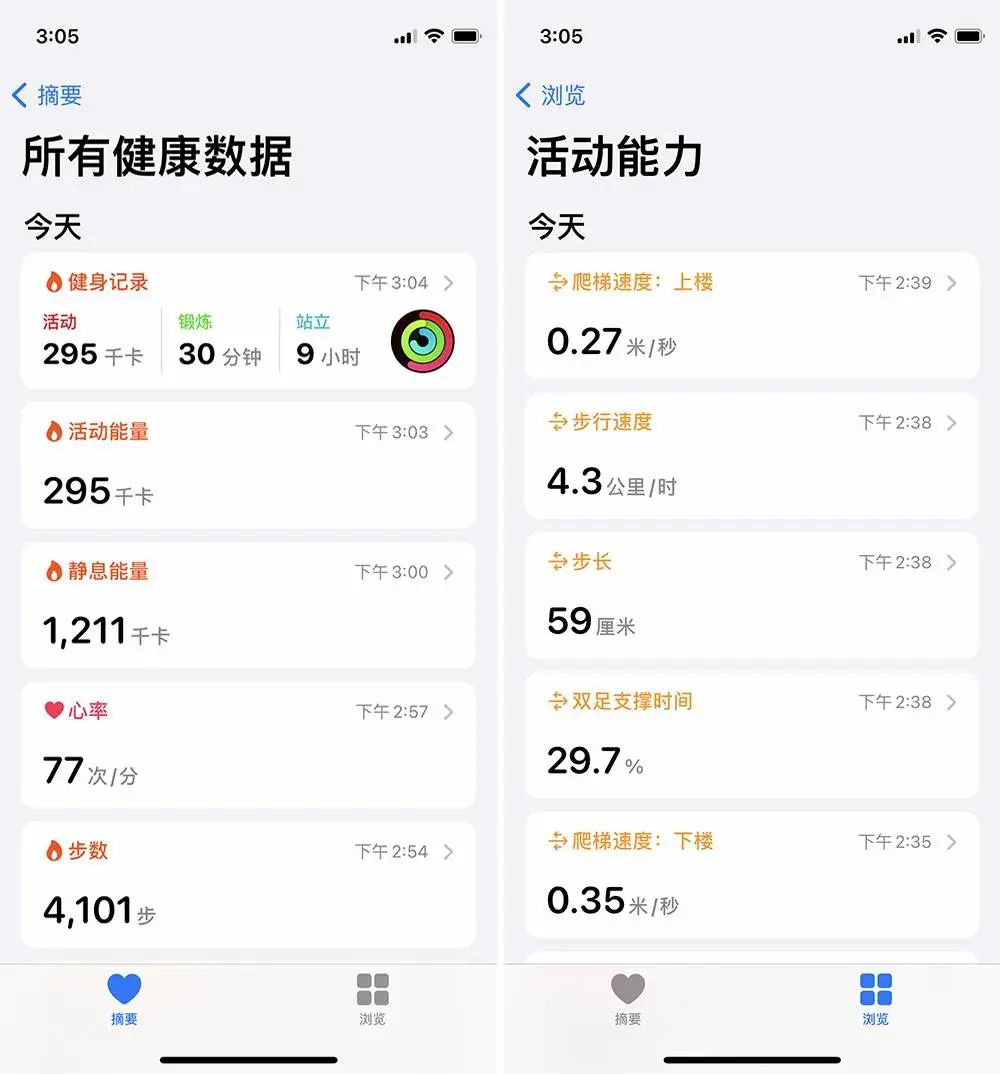 After the watchOS 7 update, the Apple Watch finally has built-in sleep tracking, but compared to domestic fitness bands that can record deep sleep, light sleep, rapid eye movement, and sleep breathing, the Apple Watch can only show how many hours you slept, which is indeed insufficient.
After the watchOS 7 update, the Apple Watch finally has built-in sleep tracking, but compared to domestic fitness bands that can record deep sleep, light sleep, rapid eye movement, and sleep breathing, the Apple Watch can only show how many hours you slept, which is indeed insufficient.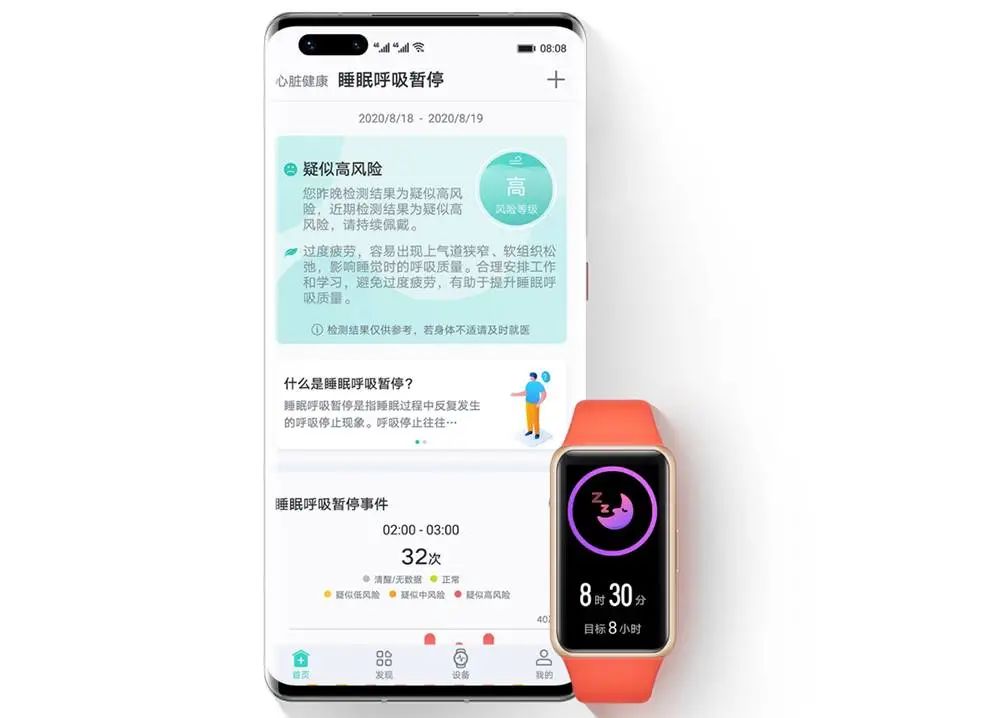 Huawei Band 6 can record sleep breathing全民健身,分秒记录According to the official websites of various brands, the Xiaomi Mi Band 6 supports 30 types of professional sports tracking, from daily running and walking to popular sports like basketball and boxing; the OPPO Watch advocates consistent exercise, with a built-in rich variety of sports tracking, and records user activity status through a four-dimensional “X” plan; the Huawei Band 6 has up to 96 types of sports modes built-in, making exercise no longer monotonous; the Apple Watch has over 80 types of sports modes to help you achieve new breakthroughs.
Huawei Band 6 can record sleep breathing全民健身,分秒记录According to the official websites of various brands, the Xiaomi Mi Band 6 supports 30 types of professional sports tracking, from daily running and walking to popular sports like basketball and boxing; the OPPO Watch advocates consistent exercise, with a built-in rich variety of sports tracking, and records user activity status through a four-dimensional “X” plan; the Huawei Band 6 has up to 96 types of sports modes built-in, making exercise no longer monotonous; the Apple Watch has over 80 types of sports modes to help you achieve new breakthroughs.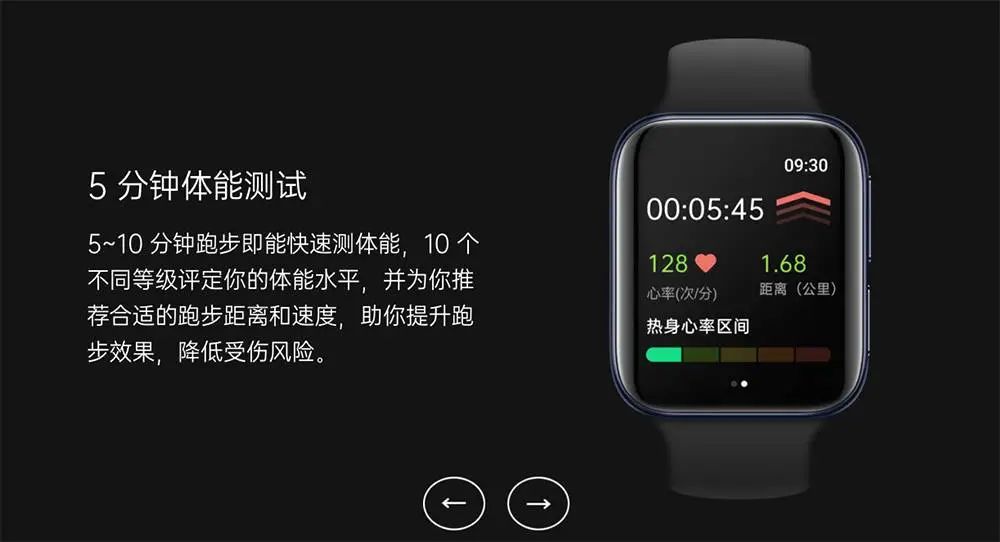 OPPO Watch can customize your fitness planDuring exercise, both smartwatches and fitness bands can clearly display various data on the screen. For example, during running, the screen will show running distance, heart rate, average speed, and other data. After the workout, the app for the band or watch will also have very detailed exercise data records, allowing you to view and share at any time.
OPPO Watch can customize your fitness planDuring exercise, both smartwatches and fitness bands can clearly display various data on the screen. For example, during running, the screen will show running distance, heart rate, average speed, and other data. After the workout, the app for the band or watch will also have very detailed exercise data records, allowing you to view and share at any time.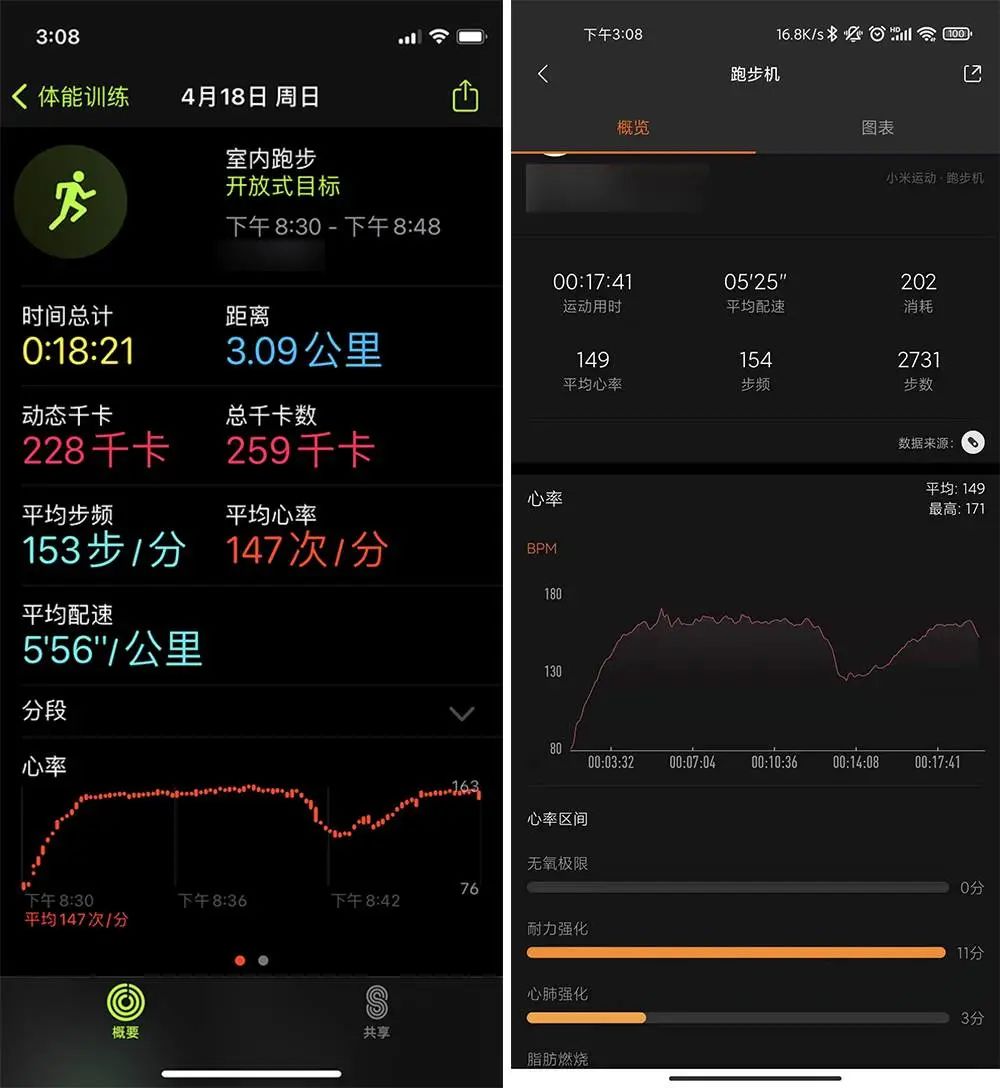 Left: Fitness app, Right: Xiaomi Mi Band appAdding some spice to a healthy lifeJust like OPPO advocates a more natural way of exercising, both fitness bands and smartwatches hope you can stick to your workouts. The OPPO Watch provides fitness tests to customize exercise plans for everyone and hosts various fitness activities to motivate you; the Apple Watch uses rich badges and friend competitions to encourage you and your friends to exercise; the Xiaomi Mi Band can interact with various smart hardware, allowing you to record weight and body fat in one app, gaining a better understanding of your body data.
Left: Fitness app, Right: Xiaomi Mi Band appAdding some spice to a healthy lifeJust like OPPO advocates a more natural way of exercising, both fitness bands and smartwatches hope you can stick to your workouts. The OPPO Watch provides fitness tests to customize exercise plans for everyone and hosts various fitness activities to motivate you; the Apple Watch uses rich badges and friend competitions to encourage you and your friends to exercise; the Xiaomi Mi Band can interact with various smart hardware, allowing you to record weight and body fat in one app, gaining a better understanding of your body data.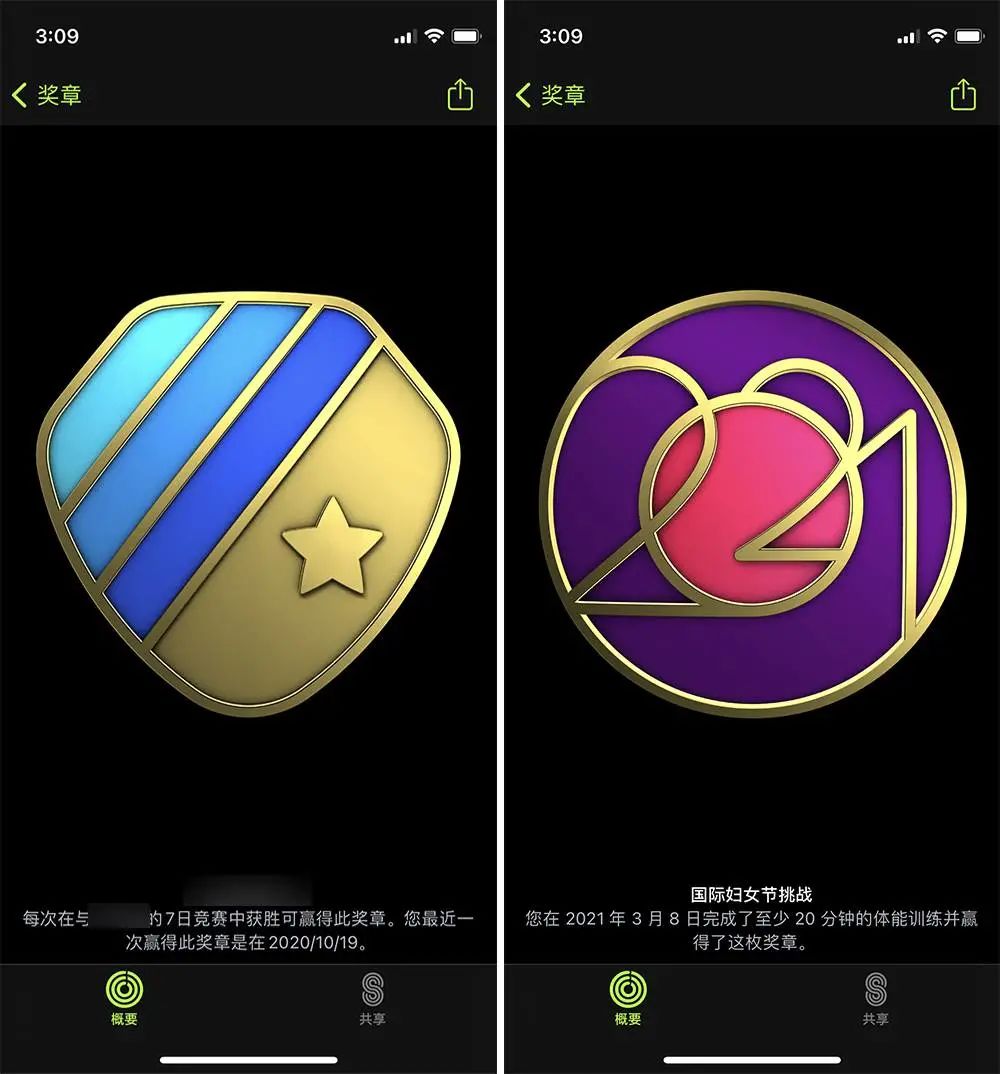 As long as you follow the prompts from these wearable devices to exercise, adjust your diet and sleep, you will surely achieve a healthy lifestyle. At this point, you may have a question: the smartwatches priced at two to three thousand Yuan do not seem to be significantly better in health aspects than the fitness bands priced at a few hundred Yuan. If you have this thought, I regret to inform you: it is indeed true. When I browsed the introduction pages of various brands, facing nearly a hundred supported sports, I felt a strong desire to purchase, thinking that having one would enrich my fitness life. However, in reality, when I exercise, they only record the most basic heart rate, calories, and exercise time.
As long as you follow the prompts from these wearable devices to exercise, adjust your diet and sleep, you will surely achieve a healthy lifestyle. At this point, you may have a question: the smartwatches priced at two to three thousand Yuan do not seem to be significantly better in health aspects than the fitness bands priced at a few hundred Yuan. If you have this thought, I regret to inform you: it is indeed true. When I browsed the introduction pages of various brands, facing nearly a hundred supported sports, I felt a strong desire to purchase, thinking that having one would enrich my fitness life. However, in reality, when I exercise, they only record the most basic heart rate, calories, and exercise time.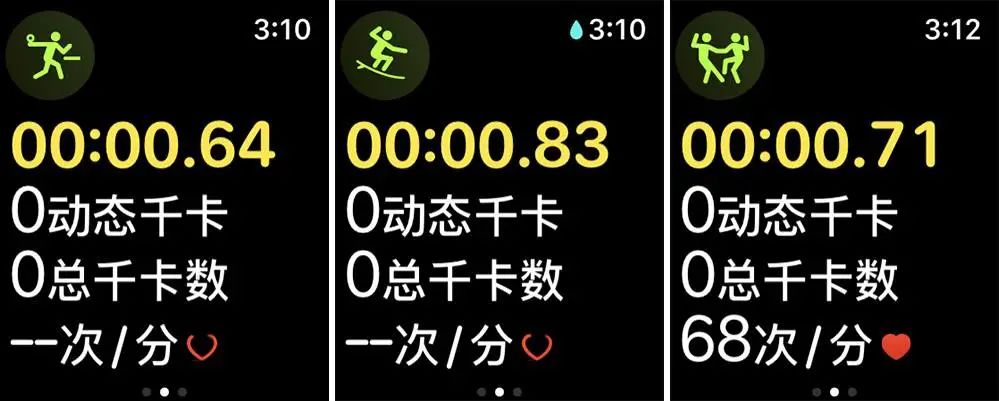 Apple Watch records table tennis, surfing, social dance, etc. The same situation occurs with the Xiaomi Mi Band; although there are many sports options, the recorded data is just heart rate and calories—rich sports forms are more to clarify your tracking rather than optimize for specific exercises.
Apple Watch records table tennis, surfing, social dance, etc. The same situation occurs with the Xiaomi Mi Band; although there are many sports options, the recorded data is just heart rate and calories—rich sports forms are more to clarify your tracking rather than optimize for specific exercises.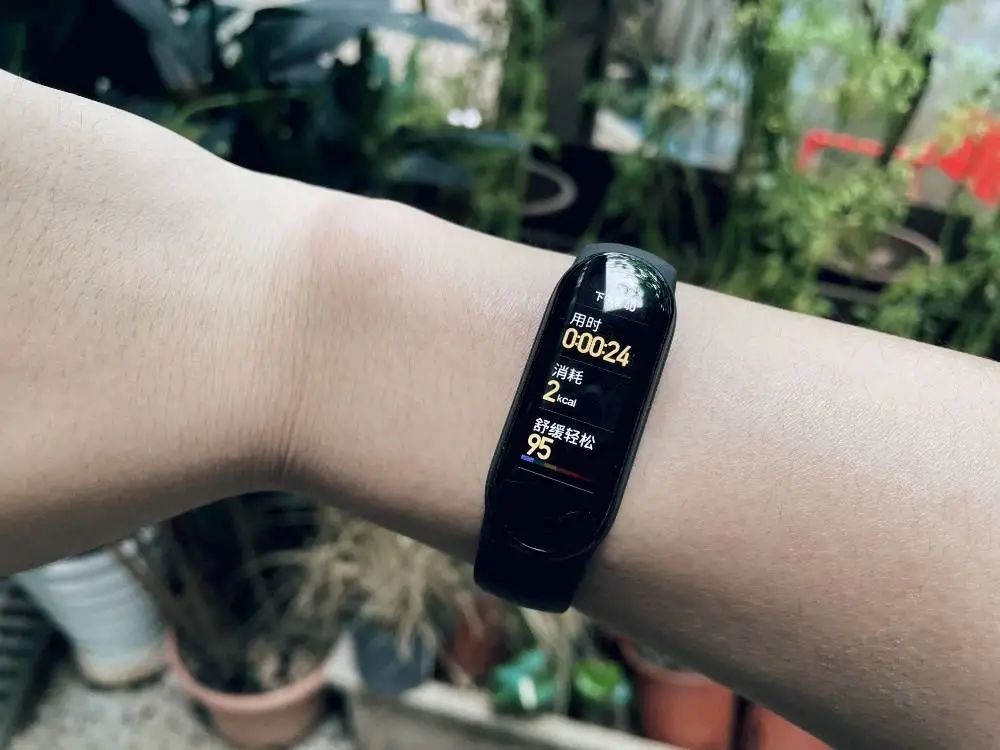 Xiaomi Mi Band 6 recording rowing machineMoreover, the most important thing is that although wearable devices support a wide range of sports, the actual sports we each do are relatively stable (like running, swimming), so confirming that the wearable device has tracking functions for the sports you commonly do is sufficient; supporting more sports is not very meaningful for us personally.
Xiaomi Mi Band 6 recording rowing machineMoreover, the most important thing is that although wearable devices support a wide range of sports, the actual sports we each do are relatively stable (like running, swimming), so confirming that the wearable device has tracking functions for the sports you commonly do is sufficient; supporting more sports is not very meaningful for us personally.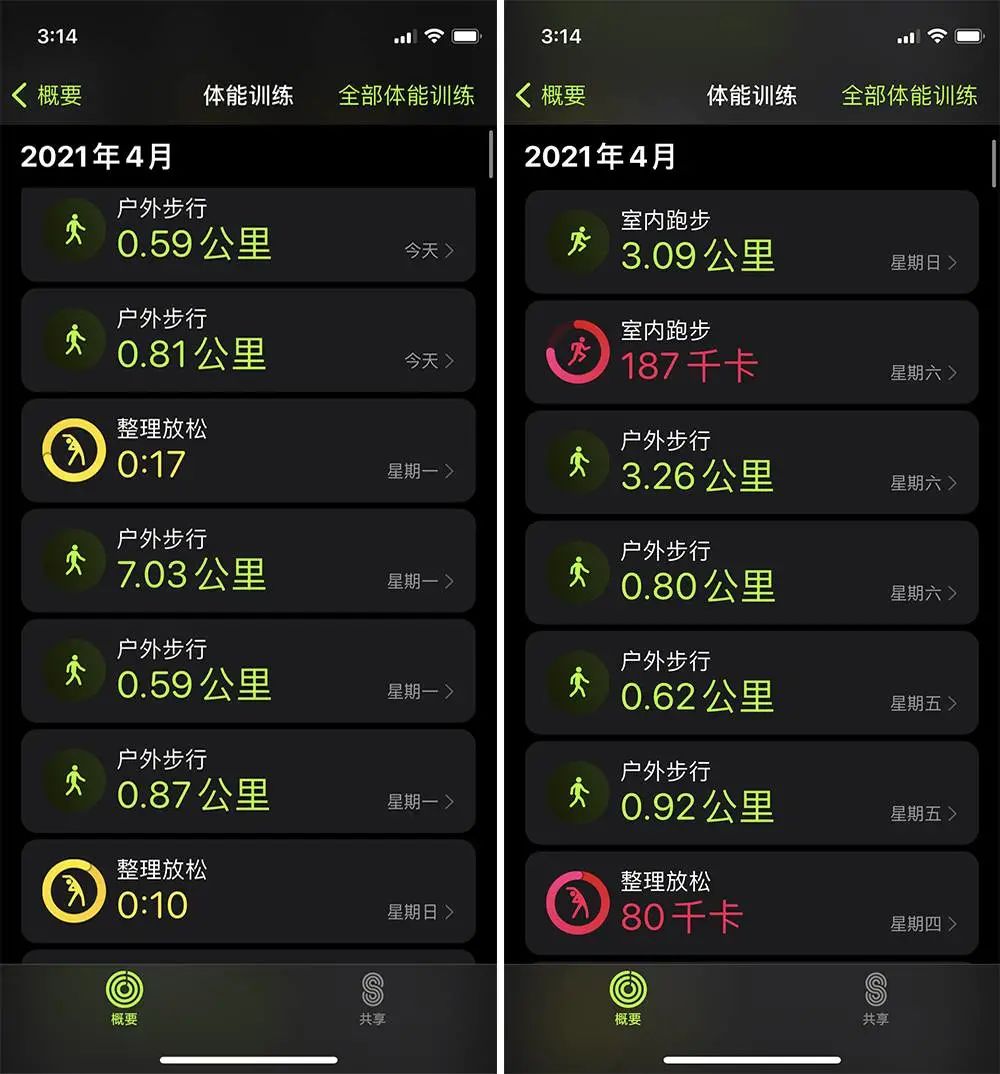 For example, I am a running enthusiast. As for accuracy in tracking, when running 5 kilometers on a treadmill, the Xiaomi Mi Band recorded a distance of 5.96 kilometers, while the Apple Watch recorded 5.11 kilometers; during outdoor walking, for the same distance, the Xiaomi Mi Band recorded 7.18 kilometers, and the Apple Watch recorded 7.03 kilometers.
For example, I am a running enthusiast. As for accuracy in tracking, when running 5 kilometers on a treadmill, the Xiaomi Mi Band recorded a distance of 5.96 kilometers, while the Apple Watch recorded 5.11 kilometers; during outdoor walking, for the same distance, the Xiaomi Mi Band recorded 7.18 kilometers, and the Apple Watch recorded 7.03 kilometers.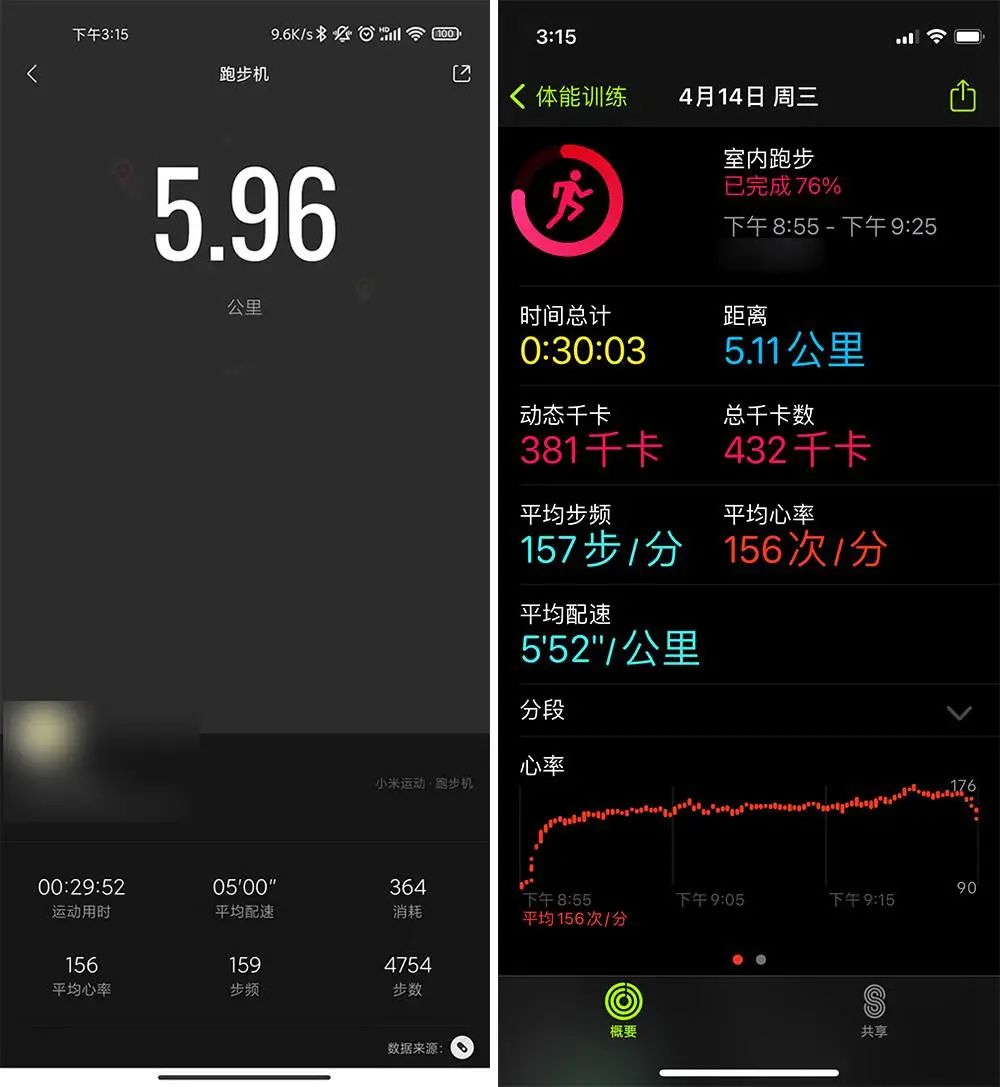 Running comparison, left is Xiaomi Mi Band app, right is fitness app
Running comparison, left is Xiaomi Mi Band app, right is fitness app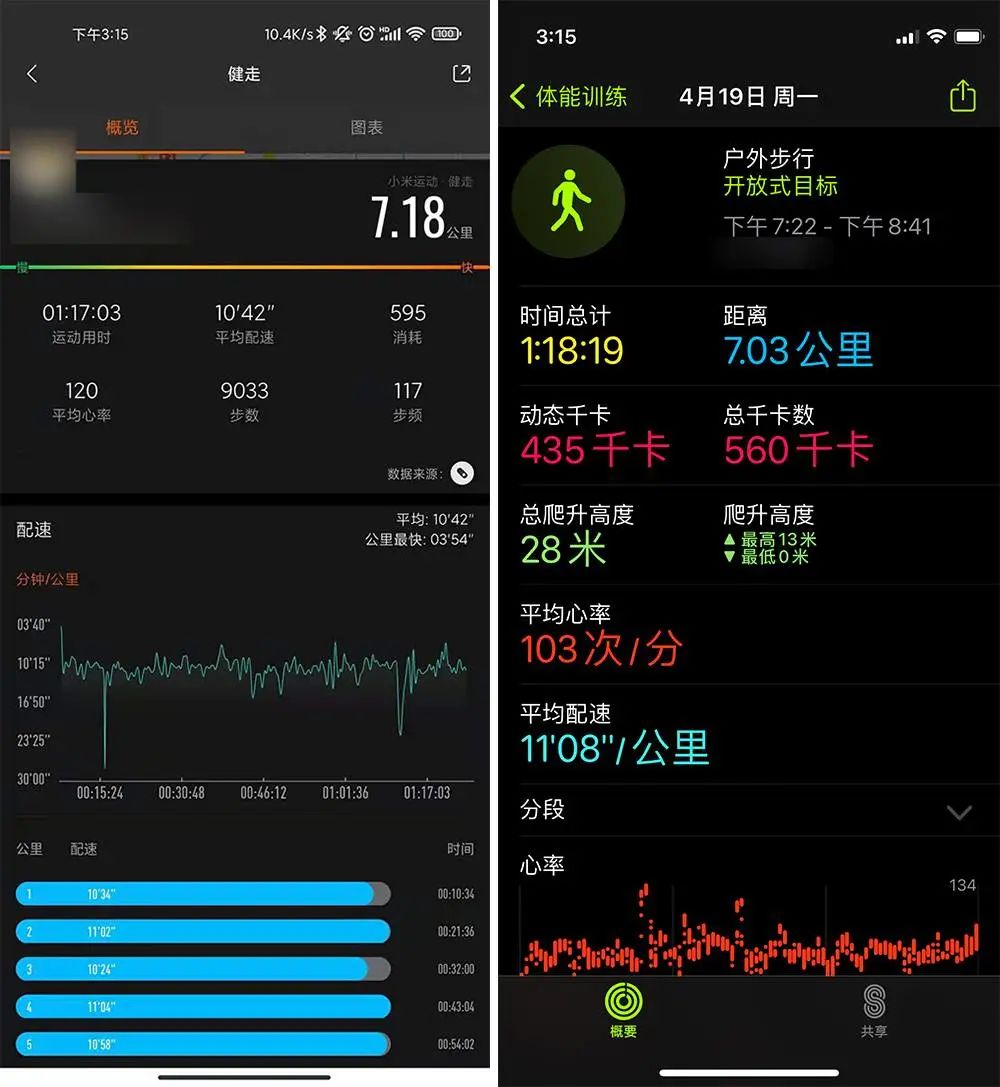 Outdoor walking comparison, left is Xiaomi Mi Band app, right is fitness appOf course, we also know that the tightness of the wearable device can affect heart rate data, and the stability of GPS can affect speed and distance tracking. Different manufacturers have different ways of handling exercise situations; for example, the Xiaomi Mi Band stops recording when waiting at a red light, which is very sensitive, while the Apple Watch will ask if you want to stop exercising after standing for a long time—wearable devices are more for auxiliary monitoring rather than accurate recording. Smartwatches have larger screens and more intuitive operations, allowing you to quickly enter exercise with a few clicks, and you can place fitness apps on the watch face for direct access.
Outdoor walking comparison, left is Xiaomi Mi Band app, right is fitness appOf course, we also know that the tightness of the wearable device can affect heart rate data, and the stability of GPS can affect speed and distance tracking. Different manufacturers have different ways of handling exercise situations; for example, the Xiaomi Mi Band stops recording when waiting at a red light, which is very sensitive, while the Apple Watch will ask if you want to stop exercising after standing for a long time—wearable devices are more for auxiliary monitoring rather than accurate recording. Smartwatches have larger screens and more intuitive operations, allowing you to quickly enter exercise with a few clicks, and you can place fitness apps on the watch face for direct access.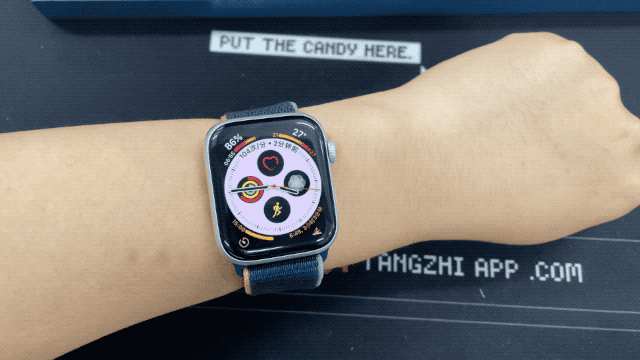 The operation of the fitness band is slightly cumbersome, but its longer battery life and lighter, more suitable design for exercise will certainly appeal to many users.
The operation of the fitness band is slightly cumbersome, but its longer battery life and lighter, more suitable design for exercise will certainly appeal to many users. A versatile user experienceIn addition to exercise, various manufacturers have added many practical daily functions to wearable devices, the most commonly used being public transport cards, music control, and installing third-party apps. Commuting payments, one is enoughThanks to the existence of national transportation cards, a “Jing-Jin-Ji Interconnectivity Card” is almost universally accepted across the country, allowing us to travel nationwide with just one band, so there are no significant issues regarding support for transportation cards in various cities.
A versatile user experienceIn addition to exercise, various manufacturers have added many practical daily functions to wearable devices, the most commonly used being public transport cards, music control, and installing third-party apps. Commuting payments, one is enoughThanks to the existence of national transportation cards, a “Jing-Jin-Ji Interconnectivity Card” is almost universally accepted across the country, allowing us to travel nationwide with just one band, so there are no significant issues regarding support for transportation cards in various cities.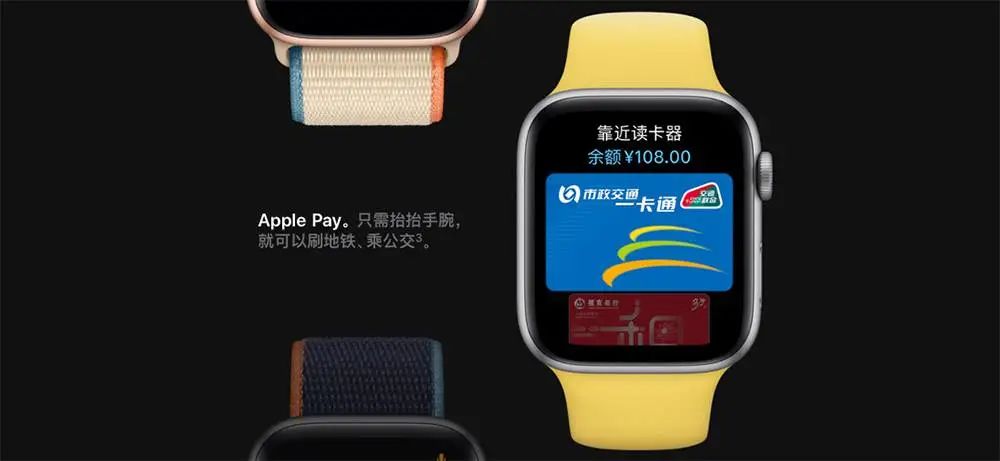 In terms of payment, apart from supporting Alipay QR codes, both the Xiaomi Mi Band and Apple Watch can also bind debit and credit cards. However, in practical experience, the acceptance of watch payments in offline stores is still low; there are frequent encounters with issues like not knowing what Apple Pay is, or the small screen of the band making it difficult to scan codes, and in scenarios where a payment code needs to be presented, wearable devices without cameras are completely powerless.
In terms of payment, apart from supporting Alipay QR codes, both the Xiaomi Mi Band and Apple Watch can also bind debit and credit cards. However, in practical experience, the acceptance of watch payments in offline stores is still low; there are frequent encounters with issues like not knowing what Apple Pay is, or the small screen of the band making it difficult to scan codes, and in scenarios where a payment code needs to be presented, wearable devices without cameras are completely powerless. How does this code scan?Music entertainment, which is more user-friendly? Whether on the commute or in the gym, music is our good companion. Wearable devices act as music control remotes when we cannot conveniently use our phones. We compared the Xiaomi Mi Band 6 with the Apple Watch SE. On the Xiaomi Mi Band, we can swipe right to enter the music control interface (the menu order can be adjusted) to perform previous song, next song, and pause operations.
How does this code scan?Music entertainment, which is more user-friendly? Whether on the commute or in the gym, music is our good companion. Wearable devices act as music control remotes when we cannot conveniently use our phones. We compared the Xiaomi Mi Band 6 with the Apple Watch SE. On the Xiaomi Mi Band, we can swipe right to enter the music control interface (the menu order can be adjusted) to perform previous song, next song, and pause operations.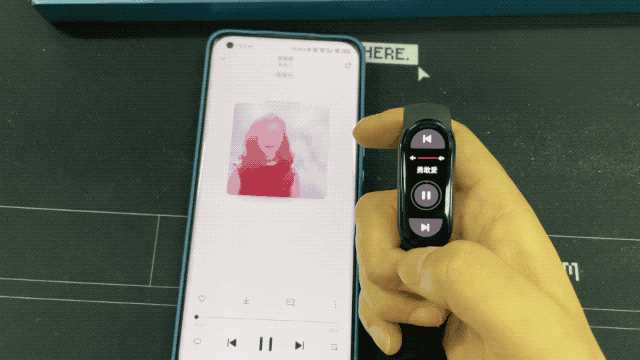 The Apple Watch, with its larger screen, offers more options for music control. Not only can you switch between songs, but you can also easily set the looping method and various song settings.
The Apple Watch, with its larger screen, offers more options for music control. Not only can you switch between songs, but you can also easily set the looping method and various song settings.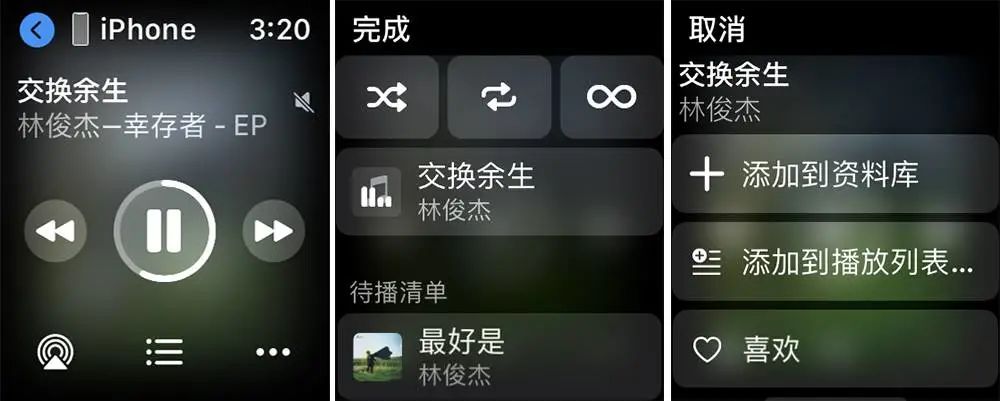 You can even download songs directly to the Apple Watch for playback without a phone, while the Xiaomi Mi Band can only be used in conjunction with a phone. Of course, not all smart bands are incapable; the Huawei Watch GT2, which also uses RTOS, can import songs. Downloading apps, bands take a backseatBehind the long battery life of many smart bands is the inability to download apps due to their minimalist functionality. In terms of downloading apps and enriching wearable device functions, smartwatches are undoubtedly in a league of their own.
You can even download songs directly to the Apple Watch for playback without a phone, while the Xiaomi Mi Band can only be used in conjunction with a phone. Of course, not all smart bands are incapable; the Huawei Watch GT2, which also uses RTOS, can import songs. Downloading apps, bands take a backseatBehind the long battery life of many smart bands is the inability to download apps due to their minimalist functionality. In terms of downloading apps and enriching wearable device functions, smartwatches are undoubtedly in a league of their own.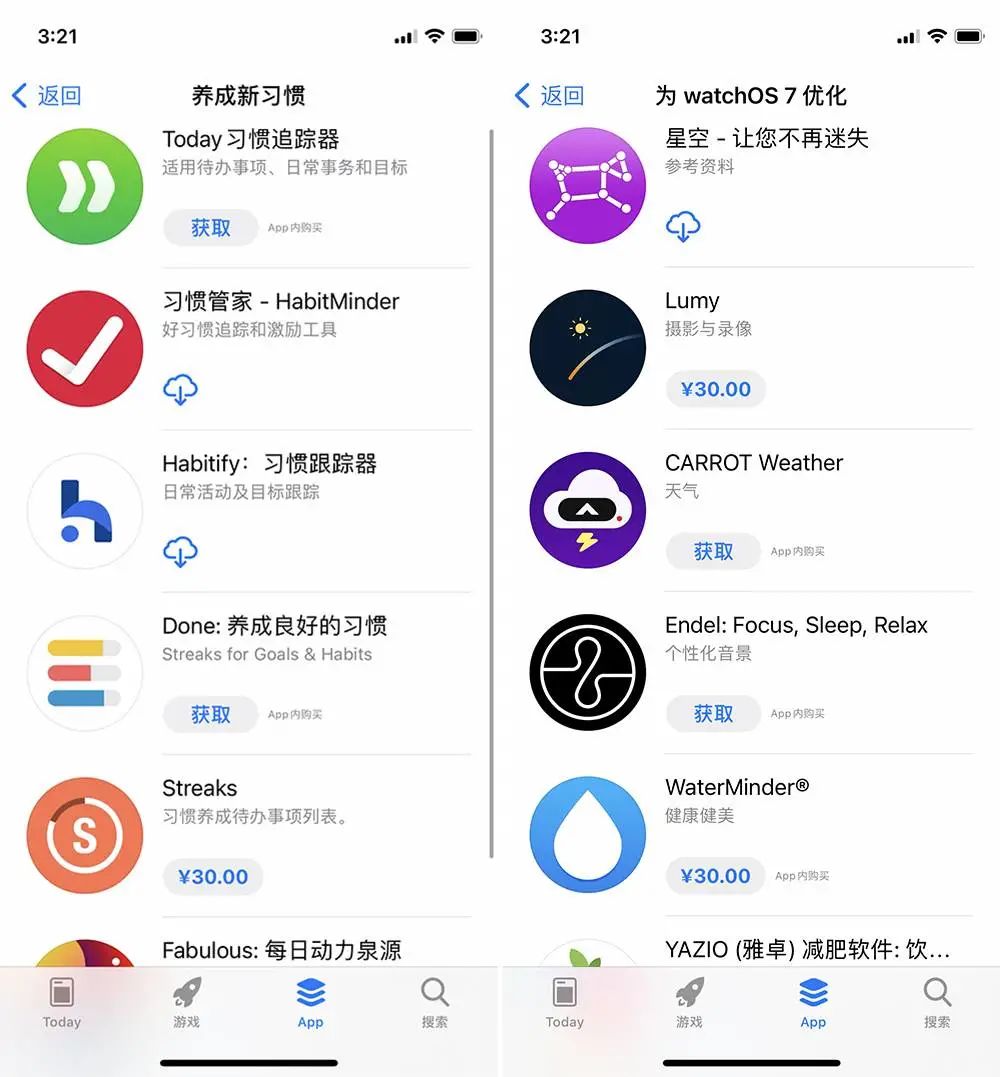 The Watch section of the App StoreIf the built-in sleep tracking is not accurate enough, “AutoSleep” automatically tracks your sleep and analyzes sleep quality; if the watch is too limited in functionality, “Infinite Loop” allows you to enjoy easy, endless meditation; you can even use “Shortcuts” on the Apple Watch to quickly complete various tasks.
The Watch section of the App StoreIf the built-in sleep tracking is not accurate enough, “AutoSleep” automatically tracks your sleep and analyzes sleep quality; if the watch is too limited in functionality, “Infinite Loop” allows you to enjoy easy, endless meditation; you can even use “Shortcuts” on the Apple Watch to quickly complete various tasks.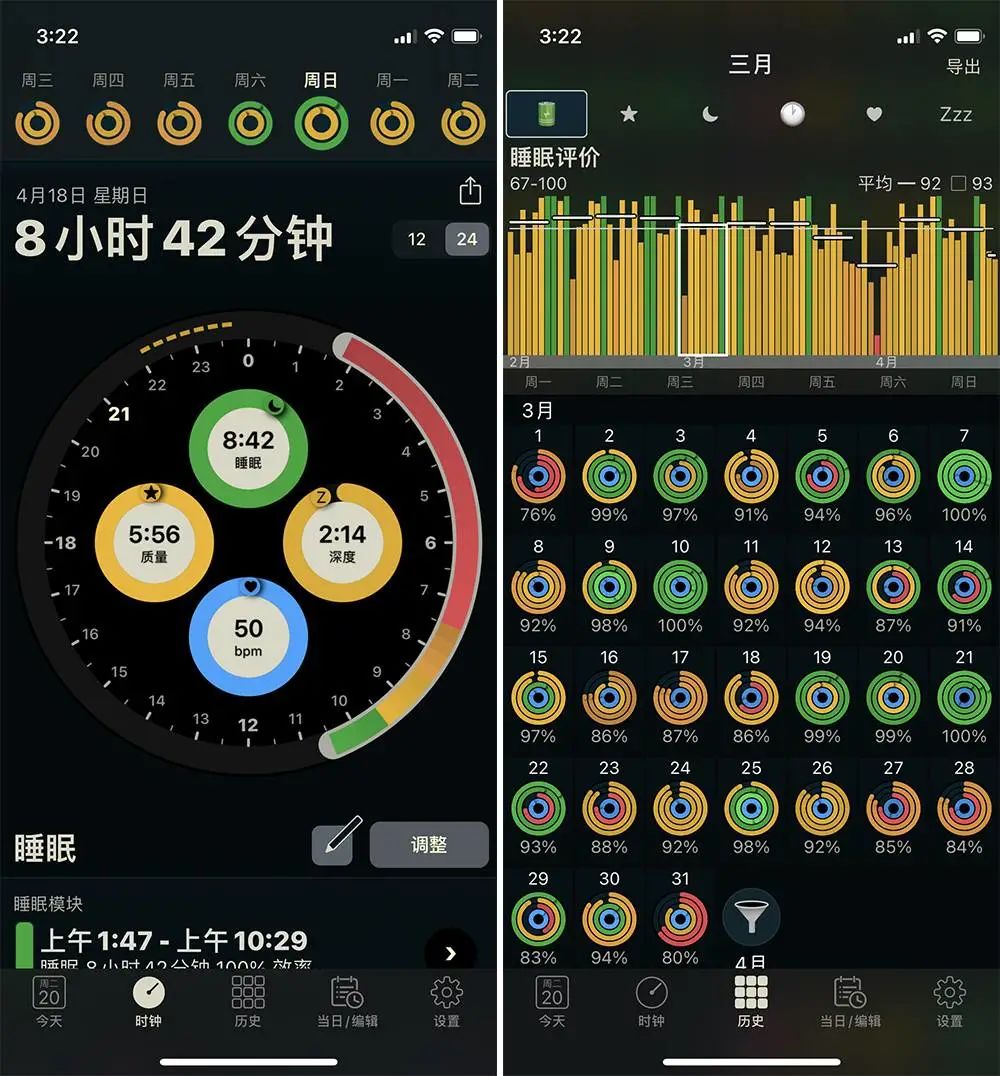 AutoSleepUsing Android-based OPPO Watch and Wear OS-based Xiaomi Watch also allows app downloads, but compared to the Apple Watch, the options are much fewer.
AutoSleepUsing Android-based OPPO Watch and Wear OS-based Xiaomi Watch also allows app downloads, but compared to the Apple Watch, the options are much fewer.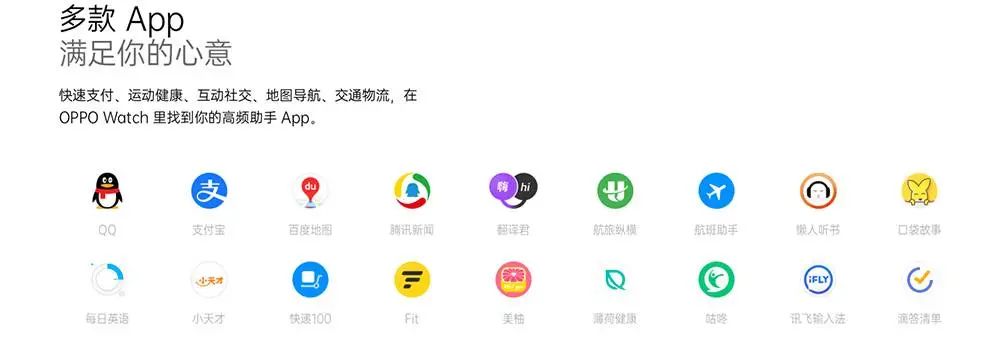 The available apps are limitedIn summary, the long-lasting smart bands and watches use RTOS, which cannot install apps, but they have no problem with common functions like public transport, payments, and music playback control; however, their playability is somewhat lacking. In contrast, smartwatches represented by the Apple Watch (running watchOS, Android, and WearOS) have much higher playability than fitness bands, and if manufacturers are willing to maintain them for a long time, they will have even more features in the future.
The available apps are limitedIn summary, the long-lasting smart bands and watches use RTOS, which cannot install apps, but they have no problem with common functions like public transport, payments, and music playback control; however, their playability is somewhat lacking. In contrast, smartwatches represented by the Apple Watch (running watchOS, Android, and WearOS) have much higher playability than fitness bands, and if manufacturers are willing to maintain them for a long time, they will have even more features in the future. For the aesthetic enthusiasts? Want to change the strap or watch face? In addition to functionality, another important aspect of smartwatches is their decorative nature. Different watch faces and straps not only match outfits but also showcase different personalities. In terms of customization, the Apple Watch stands out. In the Apple Watch customization shop on the official website, you can pair different sizes, materials, and straps, and place an order directly after completion, which is very convenient and intuitive.
For the aesthetic enthusiasts? Want to change the strap or watch face? In addition to functionality, another important aspect of smartwatches is their decorative nature. Different watch faces and straps not only match outfits but also showcase different personalities. In terms of customization, the Apple Watch stands out. In the Apple Watch customization shop on the official website, you can pair different sizes, materials, and straps, and place an order directly after completion, which is very convenient and intuitive.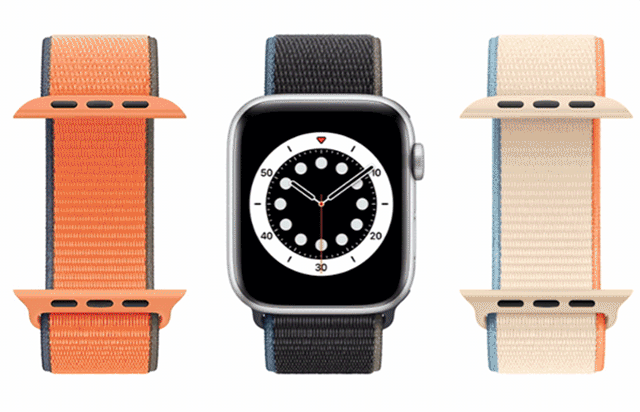 In contrast, other brands have fewer options; the newly launched Xiaomi Mi Band 6 currently has no alternative straps available, while the Xiaomi Mi Band 5 only has five new colors of the same material; the OPPO Watch has ten different package combinations, but there are no separate strap options; the Huawei Band 6 also offers a few package combinations without more choices.
In contrast, other brands have fewer options; the newly launched Xiaomi Mi Band 6 currently has no alternative straps available, while the Xiaomi Mi Band 5 only has five new colors of the same material; the OPPO Watch has ten different package combinations, but there are no separate strap options; the Huawei Band 6 also offers a few package combinations without more choices.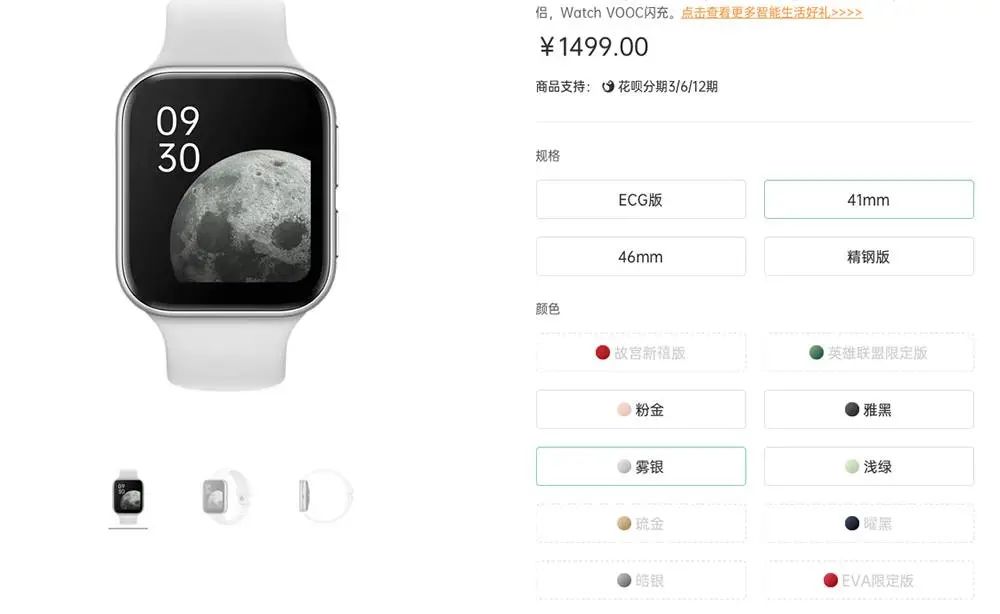 While there are hardware differences, in terms of watch faces, each brand showcases its strengths; the Apple Watch has many built-in watch faces, and every time a new system or watch is released, the updates to the watch faces are a major highlight.
While there are hardware differences, in terms of watch faces, each brand showcases its strengths; the Apple Watch has many built-in watch faces, and every time a new system or watch is released, the updates to the watch faces are a major highlight.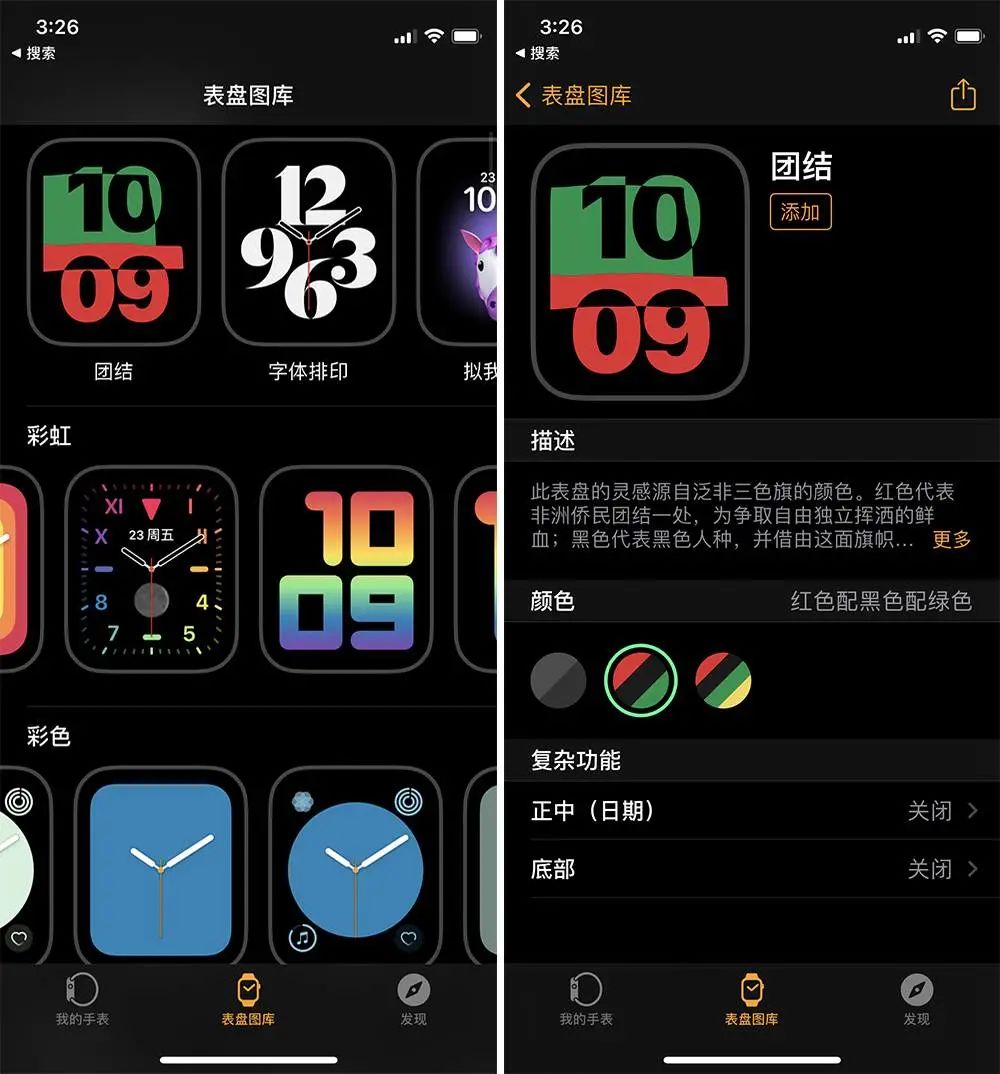 Smart fitness bands have not fallen behind either; whether it’s the trending Huawei “Astronaut” watch face or the numerous IP watch faces from collaborations with Xiaomi and EVA, they have gained popularity among many users. Which is better, the watch face of a smartwatch or a fitness band? It really comes down to personal preference.
Smart fitness bands have not fallen behind either; whether it’s the trending Huawei “Astronaut” watch face or the numerous IP watch faces from collaborations with Xiaomi and EVA, they have gained popularity among many users. Which is better, the watch face of a smartwatch or a fitness band? It really comes down to personal preference.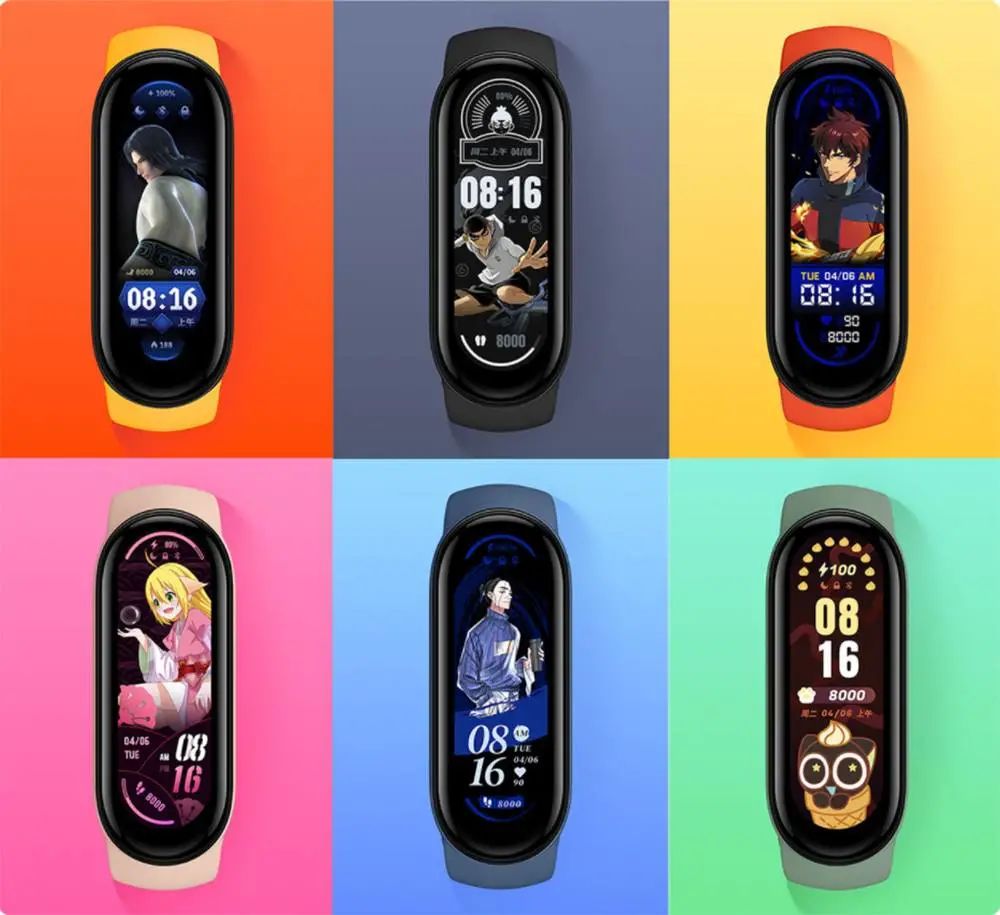 After all this, which wearable device is the best, and why is the Apple Watch so much more expensive than ordinary fitness bands? Indeed, the tenfold price difference does not make the Apple Watch significantly better than the few hundred Yuan fitness bands in every aspect; rather, its daily battery life is worse than that of fitness bands by more than ten times. While it can download apps and expand the watch’s functionality (including other WearOS and Android watches), the most common operation for wearable devices is simply lifting the wrist, glancing at it, and putting it down.
After all this, which wearable device is the best, and why is the Apple Watch so much more expensive than ordinary fitness bands? Indeed, the tenfold price difference does not make the Apple Watch significantly better than the few hundred Yuan fitness bands in every aspect; rather, its daily battery life is worse than that of fitness bands by more than ten times. While it can download apps and expand the watch’s functionality (including other WearOS and Android watches), the most common operation for wearable devices is simply lifting the wrist, glancing at it, and putting it down.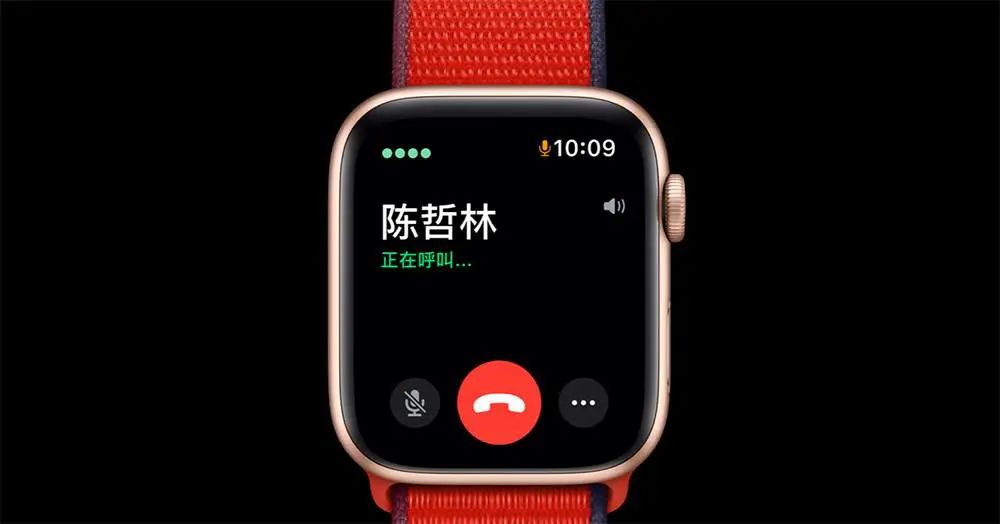 Can the battery last even when used independently of the phone? Moreover, when manufacturers promote various practical functions and fitness monitoring of wearable devices, they often include a note stating: “The detection data and results of this product are for reference only and are not for diagnostic or medical purposes.” Manufacturers are well aware that health data is not accurate and can only be used as a reference.
Can the battery last even when used independently of the phone? Moreover, when manufacturers promote various practical functions and fitness monitoring of wearable devices, they often include a note stating: “The detection data and results of this product are for reference only and are not for diagnostic or medical purposes.” Manufacturers are well aware that health data is not accurate and can only be used as a reference.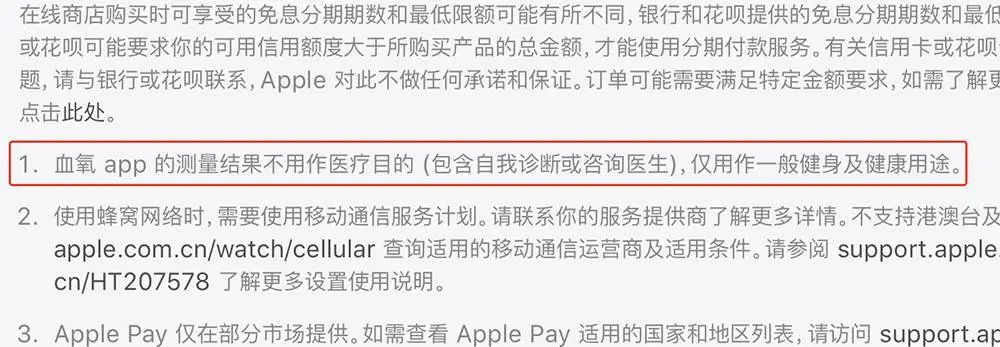 Even Apple cannot guarantee data accuracyDo not blindly trust the powerful functions of expensive watches, nor overestimate the practical value of a few hundred Yuan fitness bands—the first step in purchasing a smartwatch or fitness band is whether you can get used to wearing it daily to record data and facilitate life. Here, I also provide a simple process for selecting smart wearable devices for your reference: Can you adapt to wearing a watch every day and charging it on time? If you want to record data, wearing it daily is a must; if you cannot charge it on time or persist in wearing it, then give it up. What features do you value most? If you value sleep tracking, a smaller, more comfortable band is more suitable for you; if you value expanded functionality, a fully-featured smartwatch is more suitable for you. Following the crowd will not bring you a better experience. Purchasing a wearable device that matches your phone is not to mention the Apple Watch, which is exclusive to the iPhone; even domestic fitness bands from the same manufacturer can only exert their full potential when paired with their phones; otherwise, you may need to download several apps, and some functions may not be available.
Even Apple cannot guarantee data accuracyDo not blindly trust the powerful functions of expensive watches, nor overestimate the practical value of a few hundred Yuan fitness bands—the first step in purchasing a smartwatch or fitness band is whether you can get used to wearing it daily to record data and facilitate life. Here, I also provide a simple process for selecting smart wearable devices for your reference: Can you adapt to wearing a watch every day and charging it on time? If you want to record data, wearing it daily is a must; if you cannot charge it on time or persist in wearing it, then give it up. What features do you value most? If you value sleep tracking, a smaller, more comfortable band is more suitable for you; if you value expanded functionality, a fully-featured smartwatch is more suitable for you. Following the crowd will not bring you a better experience. Purchasing a wearable device that matches your phone is not to mention the Apple Watch, which is exclusive to the iPhone; even domestic fitness bands from the same manufacturer can only exert their full potential when paired with their phones; otherwise, you may need to download several apps, and some functions may not be available. Huawei Band 6Many features are not supported by other brand phonesThe most expensive is not necessarily the best. Compared to the Apple Watch S6, the Apple Watch SE lacks the always-on display and blood oxygen measurement. Although I am tempted by these two features, I believe they do not justify the 1000 Yuan price difference (even though I can afford it), so I chose the cheaper Apple Watch SE. The most expensive is not necessarily the most suitable for you. The most important thing for a healthy life is that buying a Kindle does not necessarily mean you will read, and getting a gym membership does not guarantee you will go. It is unrealistic to think that purchasing a wearable device will change your habits. Pay attention to rest, have regular check-ups, do not overwork, and do not push yourself too hard. When the smartwatch tells you to stand up and not sit for too long, stand up and move around. There are many ways to maintain health; simply buying a wearable device is not one of them. At this stage, there is no decisive difference in basic functions between smartwatches priced in the thousands and fitness bands priced in the hundreds. Choose the wearable device that suits you best and enjoy the healthy life it brings!
Huawei Band 6Many features are not supported by other brand phonesThe most expensive is not necessarily the best. Compared to the Apple Watch S6, the Apple Watch SE lacks the always-on display and blood oxygen measurement. Although I am tempted by these two features, I believe they do not justify the 1000 Yuan price difference (even though I can afford it), so I chose the cheaper Apple Watch SE. The most expensive is not necessarily the most suitable for you. The most important thing for a healthy life is that buying a Kindle does not necessarily mean you will read, and getting a gym membership does not guarantee you will go. It is unrealistic to think that purchasing a wearable device will change your habits. Pay attention to rest, have regular check-ups, do not overwork, and do not push yourself too hard. When the smartwatch tells you to stand up and not sit for too long, stand up and move around. There are many ways to maintain health; simply buying a wearable device is not one of them. At this stage, there is no decisive difference in basic functions between smartwatches priced in the thousands and fitness bands priced in the hundreds. Choose the wearable device that suits you best and enjoy the healthy life it brings! If you like this article, click here
If you like this article, click here